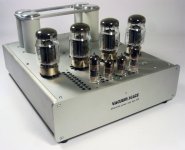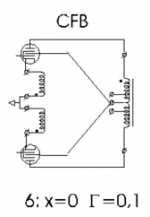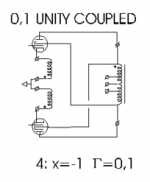The amp relies on triode mode for decent distortion/damping figures as it has no feedback. If you need the power of pentode/beam tetrode, you could try the ill-named "Schade feedback" (many threads on that here). See figure 7.32 of the Radiotron Designer's Handbook 4th Edition, or an RCA receiving tube manual such as RC30.
Kt88 or EL156
I think you are referring to a later amp that Allen developed, not the PP-1c or PP-2c. For this amp, Allen initially used an EL509, but changed to the EL156 then KT88. The changes were due to commercial availability of tubes for production. Sources of EL509 and EL156 dried up. He contended that modern KT88's sounded better than JJ sourced EL509 or Chinese EL156 in the end. The amp used a differential cascode driver (same as the others) with each arm consisting of: lower tube being a 6C45pi and the upper paralleled sections of a 6H30pi. Heaps of current in the driver. B+ was 500v. The output stage used KT88 in parallel push pull with the output transformer primary split 50% anode and 50% cathode. No overall feedback. Although not stated, putting out 150W, I'm pretty sure it wasn't a triode output stage. Hope this helps.
I think you are referring to a later amp that Allen developed, not the PP-1c or PP-2c. For this amp, Allen initially used an EL509, but changed to the EL156 then KT88. The changes were due to commercial availability of tubes for production. Sources of EL509 and EL156 dried up. He contended that modern KT88's sounded better than JJ sourced EL509 or Chinese EL156 in the end. The amp used a differential cascode driver (same as the others) with each arm consisting of: lower tube being a 6C45pi and the upper paralleled sections of a 6H30pi. Heaps of current in the driver. B+ was 500v. The output stage used KT88 in parallel push pull with the output transformer primary split 50% anode and 50% cathode. No overall feedback. Although not stated, putting out 150W, I'm pretty sure it wasn't a triode output stage. Hope this helps.
Thank you kindly for the englightening me Ejam. The reason that I ask about the El 156 was I once heard an amp using the Shuguang El 156 & it sounded much better then KT 88 when tube was switched. Yes I’ve read that the Shuguang tubes aren’t that reliable. Perhaps KT 120 would be a good choice.
Many thanks again, cheers
Many thanks again, cheers
Output Transformer
The output transformer used was a Lundahl LL1620AM. The primary has four windings with two in the anode circuit, and 2 in the cathode. I don't know how the tubes and windings were actually configured apart from the above. Did each tube have it own separate anode and cathode winding or were the tubes and windings paralleled? Maybe some residential guru can offer a suggestion. Allen did mention that there was a fair amount of current flowing through the front end, this was key to driving the output stage. Hope this helps.
The output transformer used was a Lundahl LL1620AM. The primary has four windings with two in the anode circuit, and 2 in the cathode. I don't know how the tubes and windings were actually configured apart from the above. Did each tube have it own separate anode and cathode winding or were the tubes and windings paralleled? Maybe some residential guru can offer a suggestion. Allen did mention that there was a fair amount of current flowing through the front end, this was key to driving the output stage. Hope this helps.
Attachments
Do you mean the PP-2C? Looks like the EL156 might not like triode mode with its low Vg2 rating.
Vg2 rating is given for pentode mode, but it is actually the effect of the g2 power dissipation limit. Look at datasheet, G2 voltage starts ramping up when anode voltage goes below screen grid voltage. EL156 is EL152 on steroids that has the same internals like GU-50, that is being used in triode amps with 400V or higher B+.
However, I would personally use it as a pentode, with regulated screen grid supply, and feedback from anode to the first grid. More power, lower distortions, lower output resistance than in triode mode. I consider triode mode for the most of pentodes as a waste of a tube, but YMMV.
Thanks! Most informative. However, I could not find any reference that Allan Wright ever used unity coupled output stage. Since the amplifier is rated for 150W with a pair of KT88, I suspect that it has a conventional Class AB1 push-pull output stage, but, I love to be proven wrong.The output transformer used was a Lundahl LL1620AM. The primary has four windings with two in the anode circuit, and 2 in the cathode. I don't know how the tubes and windings were actually configured apart from the above. Did each tube have it own separate anode and cathode winding or were the tubes and windings paralleled? Maybe some residential guru can offer a suggestion. Allen did mention that there was a fair amount of current flowing through the front end, this was key to driving the output stage. Hope this helps.
Look at datasheet, G2 voltage starts ramping up
Oops... Can't edit, of course I meant g2 current!
Unity Coupled It Wasn't
Jazbo8
It was not unity coupled, but used cathode feedback. Unity coupling requires the screen and anode to go to opposite ends of transformer primary. In Allen's amp the screen was powered direct from the power supply as per the Quad II arrangement, i.e. separate from the output transformer. Whereas the Quad used 10% in the cathode winding, Allen's amp used 50%. Huge swing from the driver required for this.
Jazbo8
It was not unity coupled, but used cathode feedback. Unity coupling requires the screen and anode to go to opposite ends of transformer primary. In Allen's amp the screen was powered direct from the power supply as per the Quad II arrangement, i.e. separate from the output transformer. Whereas the Quad used 10% in the cathode winding, Allen's amp used 50%. Huge swing from the driver required for this.
Whereas the Quad used 10% in the cathode winding, Allen's amp used 50%. Huge swing from the driver required for this.
The same as McIntosh.
Unity couple is just a trade name (as well as protected by patent) used by McIntosh for 50% cathode feedback. Likewise, Quad's 10% CFB is called the Acoustical Connection. McIntosh also used cross-coupled screen grid connections and tertiary windings for boostrapping the the driver stage to get as much drive/power out of the output stage, which Allen seemed to have skipped.
Funny we all seem to have different schematics.
I have one from 2004 with 6H30 in the front end and almost standard triode coupling,
with a Lundahl 1663 P-P OT. It is not completely standard, in that is has 3 common cathode bias resistors, isolated by 2 8000 uF caps. I havn´t seen that before.
I am considering change it to CFB + UL, called ´Super Triode´ as far as I remember in Menno van der Veens book. Using the new Toroid transformers from Poland.
If I dare to start the project
I have one from 2004 with 6H30 in the front end and almost standard triode coupling,
with a Lundahl 1663 P-P OT. It is not completely standard, in that is has 3 common cathode bias resistors, isolated by 2 8000 uF caps. I havn´t seen that before.
I am considering change it to CFB + UL, called ´Super Triode´ as far as I remember in Menno van der Veens book. Using the new Toroid transformers from Poland.
If I dare to start the project
Jazbo8
It was not unity coupled, but used cathode feedback. Unity coupling requires the screen and anode to go to opposite ends of transformer primary. In Allen's amp the screen was powered direct from the power supply as per the Quad II arrangement, i.e. separate from the output transformer. Whereas the Quad used 10% in the cathode winding, Allen's amp used 50%. Huge swing from the driver required for this.
Unity coupling is not limited to tetrodes or pentodes, it requires no screen at all. Unity coupling means coupling 50% cathode load with 50% anode load from
the other tube by using a bifilar wound OPT.
- Status
- This old topic is closed. If you want to reopen this topic, contact a moderator using the "Report Post" button.
- Home
- Amplifiers
- Tubes / Valves
- Allen Wright kt88/el156 pp schematics


